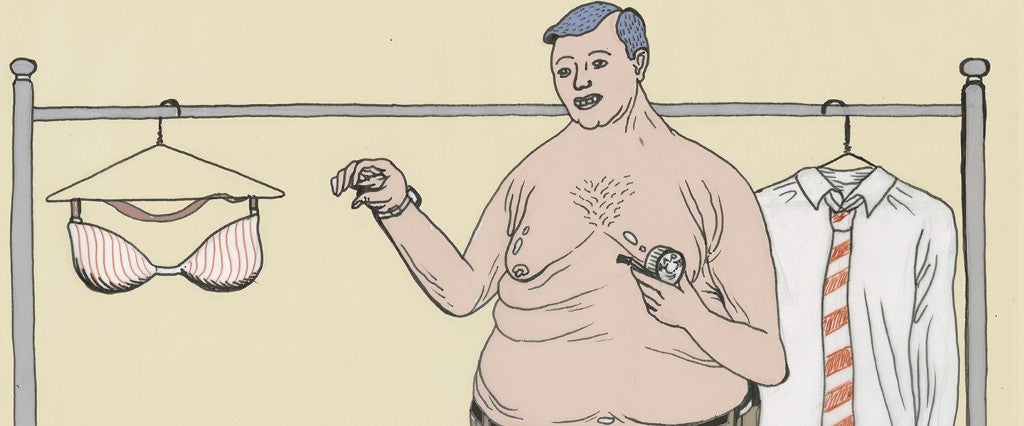While the first use of “boobs” in reference to female anatomy occurred in 1929, the mass mocking of their male equivalent is a quintessentially 21st-century obsession — one that can be traced back to a particular episode of Seinfeld. In the Season Six classic “The Doorman,” which first aired in 1995, Kramer invents the male bra — which he calls the “Bro” — after he and George witness George’s father opening his shirt. “I was throwing up all night,” says George. “It was like my own personal Crying Game.”
The expression “man boobs” doesn’t crop up there, however, and neither does its jazzier contraction “moobs”; it wouldn’t catch on, in fact, until about a decade later, as the generally accepted term for gynecomastia, the medical name for any fatty growth larger than 2 centimeters beneath the nipple. (The most famous gynecomastia sufferer ? Dwayne “The Rock” Johnson, who had corrective surgery for the condition in 2005.)
With its cuddly overtones, it’s usually intended as little more than harmless teasing, but for the millions of men affected by the condition — which at some estimates runs to between 30 and 50 percent of the adult male population — owning a pair of man boobs is no fun at all. For the current generation, man-boob misery has been made worse by the fact that in the past 10 years, the phrase has really come into own: Just try hashtagging it on Twitter or Pinterest, or better still check out this genuinely funny breast-cancer video, which won an award at the 2016 Cannes Lions advertising festival:
In September 2016, “man boobs” even received the lexical equivalent of a knighthood when the contraction “moobs” was accepted into the Oxford English Dictionary as an official British English word — although, according to the OED editors, the first recorded use of “moobs” was in American writer Ann Brashares’s novel Sisterhood of the Traveling Pants in 2001.
But all the amusing moobsing on the surface reflects a sharp increase both in clinical cases of gynecomastia and in men’s anxieties about their over-ample bosoms. According to Google Trends search data, there are now around four times as many searches including the phrase “man boobs” as there were in 2004, with interest gathering steady momentum since the start of 2005. By that September, the BBC was reporting the sudden popularity of breast-reduction surgery among British men. Perhaps marking a turning point in public consciousness, one gynecomastia specialist, Dr. Alan Kingdom, noted that the nickname had reached even the country’s most exclusive cosmetic surgeons. “We do seem to be seeing more and more of it,” he said. “There is even a slang term for it — man boobs.”
Worldwide, the number of men seeking treatment has been ballooning ever since. Figures from the American Society for Aesthetic Plastic Surgery for 2012 show that there were 22,736 surgical treatments for gynecomastia that year, an increase of 29 percent since the previous year and 104 percent over the preceding 15 years, making it the fifth most popular cosmetic procedure among men.
So what’s been driving this drift in men’s focus from women’s breasts to their own? Some point to the rise in obesity across the globe since the early 1990s, but genuine gynecomastia has more to do with hormone imbalance than with overeating. This fact has led some to blame a general leaching of estrogen into food and water supplies, supposedly thanks to a mix of waste contaminated by anabolic steroids, pesticides and pharmaceuticals (such as contraceptive pills) being recycled back into the water supply from drains and sewers. Such theories have been hotly contested by many in the scientific and medical communities, and to date, there’s no clear, authoritative consensus on the causes.
Of course, the trend for treatment might not be the result of more men developing the condition; rather, it could be because of men’s heightening awareness both of their own body image and of male breasts as an undesirable feature people are likely to notice.
In the latter case, we might have Brian Zembic to thank for the whole “aren’t man-boobs hilarious” cultural paradigm. In 1996, the Canadian high-stakes gambler became the only known case of a man who underwent surgery to acquire man boobs. Having made a $100,000 bet with a friend that he would keep a pair of breast implants for 12 months, he ended up growing attached to them, and it’s only now, 20 years later, that he’s finally thinking about having them removed.
The world’s obsession with them, however, is likely to remain.

